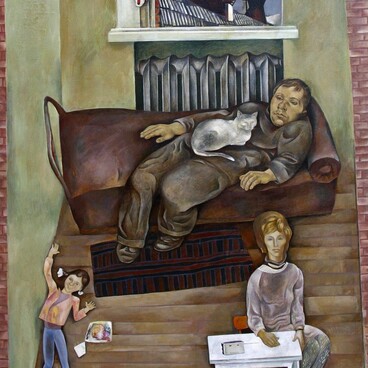Geologists were among the most demanded specialists in the USSR. It was especially so in the 1960-1970s. During that time, there were hundreds of geologist parties, and thousands of people went on expeditions. Such occupation had a romantic air, so it inspired a lot of iconic elements of that period, such as bard song festivals and hiking tours.
Some painters were influenced as well, for they began to prefer outdoor adventures to the comfort of their workshops. The Russian artist Yevgeny Shirokov from Perm depicted a prominent representative of that unspoken community.
The viewers can see a man reclining on a wooden bench, perfectly at ease. That is Yevgeny Gudin, an ex-scout on the frontlines and a famous Ural region landscape painter, who used to be Shirokov’s fellow student at the Sverdlov Art School. After the war, Gudin walked many miles on foot around Russia. He preferred regions with challenging climate and terrain conditions, such as the North and Polar Ural, Chukotka, and Sakhalin.
Yevgeny Shirokov strove to tell the exciting life story of his close friend as vividly as possible. He portrayed Gudin in a makeshift workshop, which could help understand the artist’s character better. Every element of this realistic setting speaks more of the everyday life of a geologist rather than that of a a painter: the walls lined with wooden boards, the dowdy potbelly stove, the enamel mug, the meager ration consisting of rye bread, freshwater fish, and a piece of ham. The only thing that hints at Gudin’s artistic disposition is the tubes of paint and brushes modestly lurking somewhere on the side.
Gudin is depicted in a Hemingway-like sweater that outlines his strong body. The strong-willed expression on his face and his confident posture reveal Gudin’s true nature: he seems to be a genuinely straightforward person who has chosen to live his life freely.
This painting is typical of the so-called austere style of Russian art. The painters, who belonged to that movement, opposed the moral teachings of Socialist Realism and the universal affection for family values. Instead, they decided to introduce new heroes to their paintings: severe repairmen, oil workers, polar explorers, and female pilots. The format of the paintings also differed from the official standard: their simplified modeling of forms, minimalistic color scheme, and harsh edges rather resembled poster art.
Some painters were influenced as well, for they began to prefer outdoor adventures to the comfort of their workshops. The Russian artist Yevgeny Shirokov from Perm depicted a prominent representative of that unspoken community.
The viewers can see a man reclining on a wooden bench, perfectly at ease. That is Yevgeny Gudin, an ex-scout on the frontlines and a famous Ural region landscape painter, who used to be Shirokov’s fellow student at the Sverdlov Art School. After the war, Gudin walked many miles on foot around Russia. He preferred regions with challenging climate and terrain conditions, such as the North and Polar Ural, Chukotka, and Sakhalin.
Yevgeny Shirokov strove to tell the exciting life story of his close friend as vividly as possible. He portrayed Gudin in a makeshift workshop, which could help understand the artist’s character better. Every element of this realistic setting speaks more of the everyday life of a geologist rather than that of a a painter: the walls lined with wooden boards, the dowdy potbelly stove, the enamel mug, the meager ration consisting of rye bread, freshwater fish, and a piece of ham. The only thing that hints at Gudin’s artistic disposition is the tubes of paint and brushes modestly lurking somewhere on the side.
Gudin is depicted in a Hemingway-like sweater that outlines his strong body. The strong-willed expression on his face and his confident posture reveal Gudin’s true nature: he seems to be a genuinely straightforward person who has chosen to live his life freely.
This painting is typical of the so-called austere style of Russian art. The painters, who belonged to that movement, opposed the moral teachings of Socialist Realism and the universal affection for family values. Instead, they decided to introduce new heroes to their paintings: severe repairmen, oil workers, polar explorers, and female pilots. The format of the paintings also differed from the official standard: their simplified modeling of forms, minimalistic color scheme, and harsh edges rather resembled poster art.



